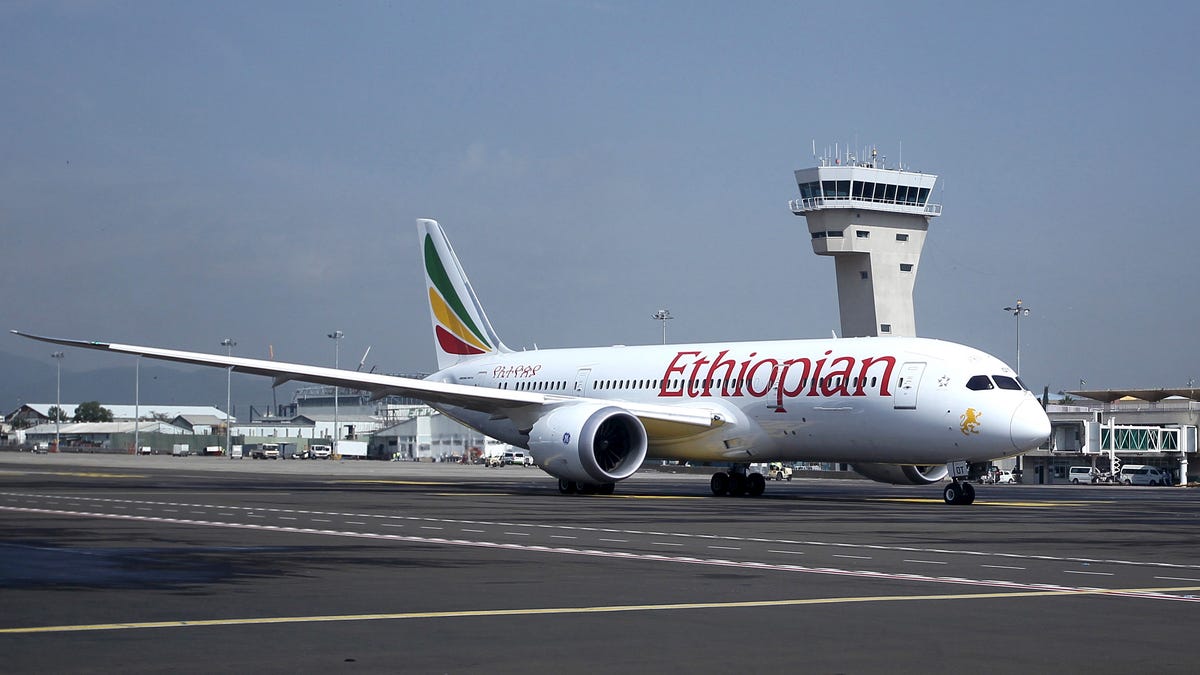The airline plans to purchase 41 more Boeing 737-8 Max planes
“Once bitten, twice shy,” doesn’t really apply to Africa’s biggest carrier, Ethiopian Airlines. Amid this year’s Dubai Air Show, the company has announced that it has ordered 20 planes of the Boeing 737-8 Max—the same model that killed 157 people six minutes after taking off from Ethiopia’s capital Addis Ababa in March 2019.
Five months earlier, a similar plane—the Lion Air 737 Max—crashed in Indonesia’s Java Sea, causing 189 instant fatalities. In both cases, investigators determined sensor malfunctions to be the cause.
Boeing admitted full responsibility for the malfunctions. The accidents led to the grounding of 737 Max models for two years; flights were resumed in June 2021.
Why is Ethiopian Airlines buying 737-8 Max planes?
Most airlines have since avoided purchasing the aircraft, with only 30 out of the world’s 5,000 airlines flying it. But Ethiopian Airlines thinks adding the model to its fleet makes business sense—despite travelers citing fears of flying in the 737 Max since the 2019 accident. “We have renewed our confidence in that aircraft,” CEO Mesfin Tasew told the press in Dubai. “We believe we have checked and confirmed that the design defect of that aircraft has been fully corrected by Boeing.”
Tasew also said Ethiopian Airlines would purchase 21 more 737 Max planes in the near future. It demonstrates, he added in a press release, the company’s commitment “to serve passengers with the latest technologically advanced airplanes.” The airline said in the release it is purchasing the model because it “reduces fuel use and emissions by 20%” while minimizing noise by 50% compared to the planes it will replace.” But returning to the plane hasn’t been without controversy for Ethiopian Airlines in the past, particularly among families of crash victims.
read more: https://qz.com/ethiopian-airlines-boeing-737-max-faa-fatal-accident-1851028514
I’ve met flight crew members that have no issue with flying on 737 MAX. They are senior enough that they could avoid it if they wanted.
Yea supposedly the issue was found and fixed?
At this point the risk should be similar to the risk of buying any new plane model, the risk of the unknown
I watched a documentary about the Max 8. It is now one of if not the most highly scrutinized planes in the world; I would fly on one now. The original issue was twofold. First, a faulty sensor that was convincing the plane software the plane was close to stalling and would thus force the plane downwards which is a problem when you’re rapidly losing altitude. The new models have an extra sensor for redundancy. Second, Boeing essentially lied to the FAA about this system because they feared the system would (rightfully) lead to an extensive testing and validation phase before approval, and thus cost them time and money. So rather than do the right thing, pilots were not adequately trained on the MCAS system at all.
It’s sad to see what Boeing has become post, McDonnell Douglas merger. The MBA ratfucks got a lot of innocent people killed over their balance sheet.
Yep, as one former Boeing CEO lamented, “McDonnell Douglas bought Boeing with Boeing’s own money”.
Exactly right, MBA ratfucks who only gave a shit about short-term profits, not quality. Everyone in & outside the industry knew Boeing was the right pick because their engineering teens would make the hard, expensive, but correct choice most of the time vs their former competitors. Quality in their parts, products, documentation, training… How the mighty have fallen.
There’s a reason McDonnell was in very real danger of going under before Boeing was urged to buy them.
Line any merger in which a failed company ends up somehow running a successful employee, we see the systematic removal of the very reasons for it’s success in the first place.
You kinda wonder why they even bother, but I guess the generation of business jerks that did it made plenty of money and it’s just one more shitty thing we get to clean up after them.
When i was a kid, a mexican restaurant chain shut down after a bunch of people got sick/died of hepatitis A in my city.
The day they reopened, it was highly publicized on the local news, and my family went there to eat… i asked my dad if he was concerned about getting sick. He stopped, looked me in the eye, and told me with the upmost confidence “i guarantee you that this will be the cleanest restaurant meal you will ever have in your life”…
i feel a similar concept applies to this situation… with all the eyes on the 737 max8, there is no way management is going to sell one if it has outstanding flaws/safety issues.
Similarly to your story, you don’t fire the IT person who makes a grave mistake that costs a lot of time/money/lost data, because you can be damn sure they’ll never, ever do that again.
Unless it was gross negligence and the person is just an idiot, any capable person will learn from their mistakes, and never make the big ones twice.
The old story:
A worker breaks an extremely expensive piece of equipment. he goes to his boss expecting to be fired, but the boss says “fire you, I just spent $3 million training you.”
A mechanic once told me: If its cheaper to pay the families of the dead than fix the issue, then they wont fix the issue.
There wasn’t even a huge issue to begin with. There was a clunky checklist and pilots didn’t get any specific training on it but I would be comfortable flying in an unmodified one with any major US or EU carrier. The planes that crashed were safely recoverable, the pilots just made ongoing mistakes for a very long time in both situations.
No that isn’t the whole story. You’ve presented just a small sliver of the overall problem with the Max.
The Max uses a new type of engine which is too large to fit underneath the wing as it did with older models. To make it fit, Boeing had to mount it just forward of the wing which significantly changes the center of gravity and thrust for the plane.
This changed the flight characteristics of the plane and Boeing engineers put controls and system over-rides in place to adjust for these differences. Unfortunately the system they put in place did not have enough backups for these new flight control systems nor did they make pilots aware of the changes or the overrides for them if something went wrong. Boeing also hid these changes from the FAA because if they had known about them it would have required a much more intensive certification process for pilots to switch from older 737s to the new Max.
I have greatly simplified the story here but as with all major disasters there were a string of failures that causes this crash. At every step of the way this disaster could have been avoided but Boeing consciously made decisions that weren’t in the interests of good engineering or public safety. In the end they paid for it financially, unfortunately the major decision makers have avoided criminal culpability.
I highly recommend that anyone who is interested in this story just do a search on YouTube to educate themselves on the Boeing Max disaster. There are great documentaries on this subject that are fascinating to watch.
OK, I finally got some time with my laptop to actually type this out. Also, I can’t get line breaks to work so I’m splitting paragraphs with hard lines for readability.
The bottom line is that most info on the 737 Max is from news sources that make money off of controversy or parties with an agenda.
Re-engining existing designs is not new and this isn’t unique to the 737-Max. The 737-100 was an old school low bypass engine that was much smaller in diameter than modern high bypass engines. When they wanted to go with more modern engines with the 737-300 they ran into the issue of the wing being too low for the wider engines and they moved it in front of the wing and up to get required ground clearance, this is also what gave the 737 the signature lopsided engine look since they put all the accessories on the sides to maximize ground clearance. For the 737-Max they were fitting even larger engines than before so they use the tried and true “move it forward and lift it technique” that had worked for decades. This did affect center of gravity and thrust (and also lift, Mean Aerodynamic Chord or MAC is equally if not more important here) and as a result introduced some pitch tendencies to power changes.
Handling characteristics are nothing to to planes, airliners, Boeing or the 737; they’re a fact of life. Wanting similar planes to handle similarly isn’t “gaming the system” or cheating, it is a desirable outcome. With fly by wire systems, handling characteristics are tunable, the same as any modern car with stability control. Teaching the system to overcome the difference in center of thrust vs MAC isn’t scandalous or evil, it’s just basic aircraft design in modern times. Also, when the FAA asks how it handles, telling them “we added software fixes to the flight controls that make it mirror previous generations, independent test pilots all agree it is comparable” is a valid answer.
Now I will break and say this is where I do disagree with some of the choices Boeing made. I am not a Boeing fanboy and despite flying a Boeing (albeit one that became a “Boeing” when they bought McDonnell Douglas). I think their shift from having engineers in charge at the executive level to bean counters from GE/3M they made decisions that have degraded the quality of their product. This doesn’t mean they aren’t safe and functional aircraft, it’s like when I bitch about Subaru putting the oil filter inside the “ring of fire” circle of hot exhaust manifold or placing the fuel filter inside the fuel tank. My main issue with the 737-Max and MCAS is the way the fly by wire corrected for the handling by using pitch trim, but I’ll explain that next.
As I said Boeing didn’t lie or hide anything, they simply did the minimum required and the FAA didn’t ask for any more when given a simple answer. The plane passed all tests and, per all the test pilots, flew the way they said it would. The issue is what happened if anything went wrong with the way that they made it fly the way they said it would. For any large aircraft, pitch trim is a big deal. Leaving the elevator deflected at cruise creates tremendous drag so instead the entire rear stabilizer moves. This is far more aerodynamic but creates a danger because the moving surface is so large that if it does go outside of the normal range, the plane becomes unflyable. Because of this, every single pilot of large planes is taught to be aware of unintended stabilizer motion. Now going back to what I was saying before, the way MCAS worked is that it was basic computer code saying “if power makes nose go up, move tail until nose goes down.” It works and all, but inducing continuous stabilizer motion just seems sloppy to me as both a pilot and a computer science degree holder. I am not an aerospace engineer though, so I’m guessing there is more to it such as elevator not having enough authority to counter it the way the stabilizer does and odds are there is a reason they picked this, I just don’t personally like it because as a pilot “stabilizer motion” scares me more than “stall, stall, stall” when the jet yells at me.
This brings me to my final point and back to what I was originally saying. Even if MCAS was a subjectively sloppy execution of a system, it should not have ever led to a fatal mishap. If a car company has a system that under very rare, unknown and specific circumstances can deflate a tire over the course of 20 highway miles or so, is it their problem for not predicting this and informing the NTSB prior to selling it to the public despite meeting all requirements and passing all tests for certification? While yes, it’s an issue and yes, the cars can be made safer once it is known, if you have 15 miles to pull over after your TPMS light comes on would you expect someone that is unaware of this car feature/flaw to keep driving for another 10 minutes, with the TPMS light on, without ever pulling over and checking their tires? That is what happened in both 737-Max crashes. No, pilots were not given specific training on MCAS, but they were absolutely trained on what to do for stabilizer motion. The fact that they had uncommanded stabilizer motion and never ran the appropriate checklists is absurdly damning of them. A huge part of pilot training for type ratings is learning how to triage situations and pick the correct checklist to run; “stabilizer motion” is virtually always the first one. Seriously, if I have an engine on fire and stabilizer motion, I’m disabling the trim before I shut down the engine, it can burn clean off the pylon for all I care, the plane can fly just fine on the remaining engines. It’s also worth saying that during mishap investigation training “blaming the pilots” is the easiest answer that is discouraged in virtually all situations. It’s never “he flipped the wrong switch” but “his training made him mistake this switch for another” or something else. Human error is the easiest scapegoat in any mishap while human factors is what can actually be changed to prevent the next one. Mishap investigation is about prevention, not blame. This is why the second crash is unforgivable. The first crew were in a bad situation beyond their skills and paid the ultimate price for it. The second crew had every resource not just available, but shoved down their throats by the entire world for weeks and still didn’t bother to even brush up on the checklist for a runaway stabilizer. Sometimes, human error is beyond human factors and this is the epitome of it.
All that aside, once there was blood in the water the sharks were sure to circle and that is how the documentaries, exposés and hit pieces on Boeing progressed on the natural cycle. There is always more to the story, but sometimes the full answer is closer to the simple answer than the long answer.
The 737 Max is the only plane that Boeing has ever made that the guys at the Boeing factory refuse to fly on. These are guys with “if it ain’t Boeing I ain’t going” bumper stickers. Unless it’s the one.
That is an ambiguous and purely anecdotal statement. Obviously a news outlet looking to paint the Max as a death trap will be able to find a guy or two to say that for the camera. Meanwhile when I lived in the Seattle area and had neighbors that worked for Boeing they all had virtually the exact same opinion as me on this, which isn’t surprising since talking to actual Boeing employees and engineers is how I developed this opinion. The main bickering and strife for employees is about the Everett plant vs Charleston plant drama. While I am sure there are people that worked for Boeing that are still scared of the Max, I actually lived near the factory and interacted with employees in both social and professional settings and never came across any. But hey, if one person is literally a trained aviation mishap investigator and another one read something on the internet purely designed to cause outrage the latter is definitely the one to focus on when talking about aviation safety.
Super weird that you are claiming all this familiarity with the factory and the motivation of the complaints without realizing that they don’t build the Max in South Carolina so that has nothing to do with this.
They also don’t build it in Everett so it’s super weird that you met so many people who worked on it there. I guess that in all your many social and professional associations with Boeing people in Everett that it just never came up at all that they build the plane fifty miles away in Renton. Even though non fictional people at Boeing are pretty goddamned specific about which airframe they work on because it literally determines where they live.
This is a fun study in how anecdotal evidence isn’t all created equal. Made up nonsense is worth quite a bit less than stuff that actually happened.
Here is an alternative Piped link(s):
Piped is a privacy-respecting open-source alternative frontend to YouTube.
I’m open-source; check me out at GitHub.
I know the entire story. I’m also a pilot who has flown Boeing aircraft, a trained aviation mishap investigator and flight safety officer. It was a slightly sloppy job done by Boeing consistent with FAA guidelines and oversight. It could have been done better but it was absolutely sufficient for standard ops. The only issue was when substandardly/proficient pilots had an issue. The jets were flyable and recoverable.
Claiming a lot of expertise for a person who has posted nothing but verifiable horse shit in this whole thread.
deleted by creator
This one specific issue was addressed. Who knows which other compromises they had to make (and hide)…
Also, what’s the bet they’re getting a great deal on the planes in an effort to regain brand trust & loyalty?
But yeah, safety isn’t a factor now.
“This thing was bad once, therefore it will continue to be bad forever”
Bro really is risking it all
I mean, if you pay attention the issue isn’t really with the plane. It’s with Boeing adding features without notifying the FAA so they don’t have to pay to retrain pilots.
In essence, capitalism strikes again. It’ll be funny if these Ethiopians actually get a great deal because Boeing decided to fuck over countries who paid full price for these.
“If I just double down I’ll win it all back!” - Ethiopian Airlines, probably
If they werent safe to fly Boeing wouldnt be selling them
Yup, that’s definitely what Boeing did the first time around when a singular sensor failure would cause a fatal nose dive.
A sensor issue which was then fixed after a long and thorough FAA investigation. Pilots wouldn’t be flying these things if they thought there was still a safety issue present, nor would the FAA approve Boeing to sell them.
Yeah mate, I understand at this moment, this is probably the most scrutinized and safe plane out there.
But OPs comment was frankly naive. The first time the 737Max was released there were major lapses at both Boeing and the FAA that cost lives. So the mere fact of Boeing selling the planes equating to safe is not established fact nor a logical conclusion.
A single sensor failure did not cause a fatal nose dive. A sensor failure led to a situation where pilots from airlines not well regarded for quality failed to correct it for between 5-10 minutes despite having suitable checklists guidance to do so. Any complex machine can be dangerous if not operated the way it was designed to be and some nations do not take aviation safety as seriously as others, planes are designed and built expecting a certain standard and failing to meet that standard can lead to dangerous situations.
A complex machine that operates significantly differently from previous versions should always require additional training in said system. Not just required reading off a manual or a checklist.
Which is exactly how Boeing lied to the FAA and other airlines. They fought hard and lied to prevent pilots having to spend any time at all in a simulator.
How they even thought a single sensor for critical controls was adequate is beyond me. I mean I’ve worked in buildings where they built in triple redundant sensors for the HVAC system.
Revisions to aircraft designs are nothing new and the amount of detail in the flight manual is often times limited to “sufficient to safely fly the plane.” The procedure for uncommanded stabilizer motion was sufficient to recover the plane in both situations, neither crew executed it properly or in time. Using fly by wire to make handling characteristics standardized is completely normal and being fed from a single sensor isn’t uncommon for a system that itself has backups. Boeing never lied to the FAA, they told them the minimum required and the FAA said it was fine; for a crew from a first world airline it was.
So, why was Boeing selling them until two of them crashed due to zero redundancy on a system capable of crashing the plane that was designed to add control inputs but was kept secret from pilots?












